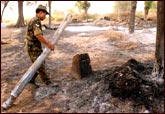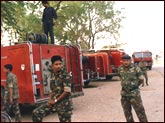The Rediff Special/Ramesh Menon


It took three disasters in a row to get New Delhi's attention.
First the Bharatpur ammunition depot went up in smoke. Then came the fire at Mamoon in Pathankot. And lastly, on May 24, the calamity at Mirdhwal near Suratgarh.
Why, and how, did we let such disasters happen one after the other?
The answer is so simple that it's scary: Negligence. A crime for which Defence Minister Jaswant Singh happily blames his predecessors.
"The absence of capital expenditure and great neglect in ammunition storage was responsible," he says. "The modernisation of the armed forces had far outstripped infrastructure facilities like ammunition depots. The capital outlay for infrastructure was ignored. We are trying to make up for the last 40 years of neglect."
Singh recently allocated Rs 2.8 billion to build storage facilities. But this, experts say, is just a fraction of what is required. "Huge investments have to be made to store ammunition scientifically," observes former army chief General (retired) Shankar Roychowdhury.
So lacking is infrastructure that depots around the country, including the ones at Mirdhwal and Pathankot, store ammunition worth billions in the open, under tarpaulin sheets.
Ammunition is a composite of chemicals and metallic components. The chemicals, if exposed to rain or high temperature over a period of time, can react with the metal and explode. In summer, for instance, the temperature in western and northern India, which oscillates between 42 and 48 degrees Celsius, is enough to trigger a fire.
That's common knowledge. But the army failed to act on it. Its only official response to the Mirdhwal incident was to absolve itself of blame.
"It is the work of God," says Vice-Chief of Army Staff Lieutenant General Vijay Oberoi. "Humans cannot be blamed."
THE Bharatpur fire cost India a neat packet -- over Rs 3.76 billion when more than 10,000 tonnes of ammunition, explosives and arms, more than what was used in the Kargil conflict, were destroyed.
 Though the next two fires came comparatively cheaper, they have eaten into the army's resources.
Though the next two fires came comparatively cheaper, they have eaten into the army's resources.
"We are conscious that this could affect our combat preparedness," Gen Oberoi admits. "Thousands of tonnes of ammunition have been stored all over the country. We are trying to rectify the errors. But the process is time- and cost-intensive."
Among the missiles lost at Bharatpur were Igla, SAM-6 and SAM-7. Lost also were ammunition for the 155mm Bofors gun and for the 130mm, 122mm and 105mm guns.
The Pathankot fire cost the nation some 450 metric tonnes of ammunition kept in the open, worth over Rs 200 million. Nothing epitomises the Indian Army's plight more than such examples, where it is forced to compromise on safety regulations.
"There will be more such fires," predicts former army chief Gen (retd) V N Sharma, "as storage for ammunition is totally inadequate."
The depot in Mamoon, Pathankot, came into existence 46 years ago. In the wars of 1962, 1965 and 1971, it was expanded. But it still fell short of space as the quantity of ammunition kept increasing year after year.
"Hundreds of letters have been written about it. But nothing happened," says Lt Gen (retd) Virendra Pratap, former director general of ordnance services, who was once in charge of the depots. "Why are we getting ammunition when we do not have the place to keep it?"
The story is the same in almost every depot. In the last 20 years not a single new storehouse has come up.
"Most of the depots have not even been expanded. We are using the same facilities that the British left us," Gen Pratap adds.
"What we today have is inappropriate storage of ammunition," Gen Roychowdhury elaborates. "Rain, moisture, dew, heat, everything can affect ammunition and render it unfit for use."
A single tank shell costs several thousand rupees. So even a small fire could result in a loss of millions.
"Ammunition needs to be respected. Any negligence, any failure in regulation is an invitation to disaster," warns Ordnance Services Director General Lt Gen D V Kalra. "Ammunition does not forgive. It makes no distinction between us and the enemy."
THE regulations are clear: there should be no habitation in a radius of 1.6 kilometres [1 mile] around an arsenal.
This is to keep civilians from harm in case of an enemy attack or a fire. But in Pathankot there were people living just 100 metres from the depot's boundary walls.
"There is not a single depot where there has been no encroachment. It is for the civil authorities to ensure this doesn't occur," says Gen Roychowdhury. "But local politicians and land sharks work together. At many places the encroachment has come almost till the wall of the depot!"
Earlier this week, a property dealer in Gurgaon offered to help this correspondent buy 100 yards outside the Indian Air Force ammunition depot at Gurgaon. He wanted Rs 2,800 per yard, and said it would cost Rs 28,000 for registering the land.
How can illegal land be registered? "The government wants revenue," the dealer laughed.
There are hundreds of illegal structures along the wall of the Gurgaon depot. There is even a road with busy traffic running just a few metres away from it.
Land in other areas of Gurgaon is more expensive. In fact, according to the dealer, the plot was ideal if "your budget is between Rs 300,000 and Rs 400,000".
 With such habitations mushrooming close, each depot is a disaster-in-waiting. "Army officials are helpless," says Gen Roychowdhury. "We cannot evict them. Politicians and civil authorities are looking at them as a potential vote bank."
With such habitations mushrooming close, each depot is a disaster-in-waiting. "Army officials are helpless," says Gen Roychowdhury. "We cannot evict them. Politicians and civil authorities are looking at them as a potential vote bank."
Thus, danger to the civilian population is a major issue. Five were killed in Bharatpur. Arjun, who ran an automobile workshop, died when a rocket blasted in through his window.
"We were terrified," said a rickshaw-puller who operated in the Bharatpur bird sanctuary, "Even as we fled, we were wondering if something would hit us."
Besides the arms and ammunition that goes up in smoke, the army incurs other hidden costs after a fire. For instance, what happens to the ammunition that is saved? Every piece is checked and rechecked to find whether it is worthy for war -- and, more significantly, whether it will trigger another disaster. If any defect is detected, it is systematically destroyed.
This is a very meticulous process and can take months. In some cases, sheds are constructed on the same spot. And in others, where the debris has smothered the stocks, it is abandoned after covering it with earth. Whatever the case, after a fire, a lot of the saved resources also go waste.
AS the recommendations of the army's inquiry into a depot fire are classified, nobody but the top brass knows what they were, and to what extent they have been implemented.
The inquiry into the Bharatpur incident, headed by Major General C B Subu, held elephant grass, poor storage, poor maintenance and extreme heat responsible. Just days after, there was another fire at the Dehu Road ammunition depot, about 20km from Pune. Again, elephant grass was blamed.
Dry grass is an open invitation for fires, especially in summer. Why, then, was the grass not cut?
Many depots today need urgent repairs, changes in electrical wiring, installation of fire-fighting systems -- and budgets to execute simple tasks like cutting grass.
"A civilised army would have machines to cut grass around a depot," comments Gen Roychowdhury. "But in India, in most cases, even contracts to cut grass cannot be worked out and troops end up doing the job with machetes."
Congress general secretary Ambika Soni, who is also a member of the Parliamentary Standing Committee on Defence, admits that storage facilities have not got priority in recent budgets. Funds were diverted to more vital areas.
"Whatever money was there was diverted to the more urgent needs of the army. Even today they do not have basic equipment to survive in difficult areas," she says.
The defence bureaucracy, she adds, "is afraid to take decisions where a lot of expenditure was involved and storage is one of those areas".
The defence ministry spokesman, Dr P K Bandyopadhyay, agrees that storage is one area that has been ignored over the years. But "with money being set aside, construction of proper storage, even at the sub-depot level, will now take place on an emergency footing", he says. But he adds a rider: "Construction of depots is a time-consuming process."
Many defence ministers have come and gone without addressing the problem. Some like Sharad Pawar, it would appear, did not even know about the problem. "I am shocked to hear that ammunition is stored in the open under tarpaulins," says Pawar, who was defence minister in the early 1990s. "It seems unbelievable."
Major General (retd) Y K Gera, who is deputy director at the United Services Institution of India, a defence research institute, puts things into perspective when he says: "Fires are because regulations are not observed. For example, grass. Norms for the periodic cutting of grass have been laid down but are not followed as local interests take over like grazing cattle and selling the grass. As they look for minor gains, safety gets compromised."
DEALING with 50 years of neglect is no mean matter. Gen Roychowdhury is the first to admit that.
 "We make wonderful missiles, but what about storage?" he asks. "Abroad, they have underground bunkers. What we do have here are a few depots made years ago for a smaller quantity of ammunition."
"We make wonderful missiles, but what about storage?" he asks. "Abroad, they have underground bunkers. What we do have here are a few depots made years ago for a smaller quantity of ammunition."
The army is estimated to have an arsenal worth around Rs 5,000 billion. Small ammunition depots would have resources anywhere between Rs 1 billion and Rs 3 billion. And small field units would have stocks of about Rs 300 million.
According to A History of the Army Ordnance Corps by Brigadier B N Rao, the need for additional storage facilities was evident way back in the 1970s. But land was not acquired, nor were resources made available for construction.
In the mid-80s, Gen Kalra was asked to find a solution to the storage problem. His report in December 1986 recommended building igloo-type depots to ensure complete safety. The igloos were to be reinforced concrete structures covered with loose earth. That is how ammunition is stored in Europe and the United States, and would ensure that the explosives were safe even in case of a fire nearby.
Gen Kalra's report is now gathering dust somewhere in the defence ministry. Why was it not implemented?
"No money was available," says former army chief Gen Roychowdhury.
Defence ministry officials divulge that ammunition and explosives worth billions of rupees, including Bofors shells costing US $1,000 apiece, are damaged by excessive heat, humidity and poor storage every year. "We cannot continue to lose ammunition like this. We do not make ammunition for it to go up in flames," says Gen Kalra.
On May 9, 1989, a major fire destroyed ammunition worth Rs 280 million in the Central Ammunition Depot, Pulgaon. Infrastructure worth about Rs 3 million was also gutted. Again, uncut grass was the reason. The massive depot in a 7,200-acre plot was built to meet World War II requirements.
"Most of the depots are legacies of the British army. They had made them with limited storage in mind," explains Gen Kalra.
Despite mammoth fires, even huge depots like the ones in Jabalpur and Pulgaon do not have adequate fire-fighting equipment. The bigger depots also get obsolete ammunition for storing, as it has to be kept somewhere before it can be destroyed.
 MAJOR FIRES
MAJOR FIRES
|
| April 13, 1990
|
Ordnance Factory, Bhandara
|
| May 27, 1992
|
Cordite Factory, Arubankudu
|
| Nov 27, 1992
|
Ordnance Factory, Itarsi
|
| April 8, 1992
|
Ammunition Factory, Kirkee
|
| Oct 10, 1994
|
Ammunition Factory, Kirkee
|
| May 5, 1995
|
Ammunition Factory, Kirkee
|
| April 28, 2000
|
Ammunition Depot, Bharatpur
|
| May 29, 2000
|
Central Ordnance Factory, Kanpur
|
| April 28, 2001
|
Ammunition Depot, Pathankot
|
| May 24, 2001
|
Ammunition Sub-Depot, Mirdhwal
|
GENERAL Kalra dismisses the charge that fires are started in the depots deliberately. "The question of engineering fires to hide spurious arms and shortage of ammunition does not arise. These are wild conjectures," he says.
Sources in the comptroller and auditor general's office said ordnance stocks are very rigorously audited and pilferage is out of question.
Different types of ammunition need to be stored differently. Certain advanced missiles need to be kept in air-conditioned depots. As such sophisticated ammunition is very costly, the less sophisticated ammo ends up being stored in the open.
"Very stringent enforcement of safety regulations, inspection standards of ammunition, and greater powers to inspection agencies will help prevent fires," says Gen Kalra.
Exhaustive rules and regulations for the storage and maintenance of arsenals, both in peace and war, have been laid down. They detail how ammunition should be stored inside and outside depots. They specify the distance at which one stack of ammunition should be kept from the next. They also require earthen embankments around the ammunition for safety.
"If all the rules and regulations are followed," says former ordnance service chief Gen Pratap, "chances of a fire become very remote."
If only...
Page design: Lynette Menezes
The Rediff Specials